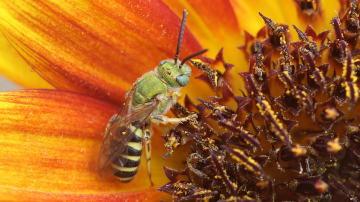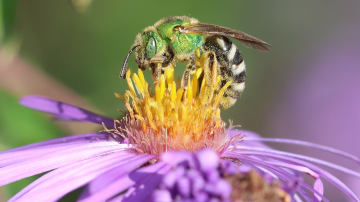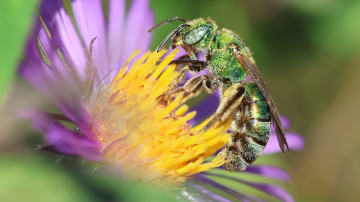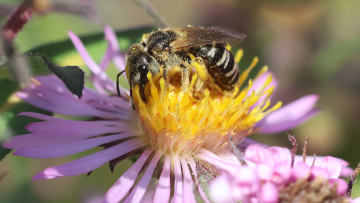Nature Notes

PHOTO COURTESY OF GARRY KESSLER
A green sweat bee (male) with yellow and black stripes (Augochlora species), nectaring on a red-and-yellow sunflower.
October 14, 2023
NATURE NOTES
By Annie Reid
Westborough Community Land Trust
Green bees
Have you ever seen a green bee?
Well, you might ask, aren’t all bees “green,” in the sense that they’re good for the environment, thanks to their pollination services?
Yes, but there really are green bees. Many are a metallic green. If you haven’t seen one, it’s probably because they’re so tiny – only 1/8 to 3/8 inch long, and quite slim. That’s much smaller than a honeybee or a bumblebee – and much smaller than you might guess from our photos.

PHOTO COURTESY OF GARRY KESSLER
A green sweat bee (female) with white and black stripes (Agapostemon species), with hairy back legs for transporting pollen, on a purple aster.
At this time of year, one of the best places to spot a green bee is a clump of purple asters. Look for a clump that’s busy with bumblebees and honeybees and watch for a while. A glint of green might catch your eye. You can find these asters growing wild in fields or planted in places like the Headquarters at MacCallum Wildlife Management Area (Westborough) or the visitor’s center at the Audubon Broad Meadow Brook wildlife sanctuary (Worcester).
Several different species of metallic green bees live in our area. Some appear all-green – that is, green on the head, middle segment (thorax), and last segment (abdomen). Others are green mainly on the head and middle segment, with stripes (yellow and black or white and black) on the last segment.
Don’t overlook white asters, goldenrods, sunflowers, and other flowers, or other seasons. Most tiny green bees seek out many kinds of flower. They also visit a variety of flowers throughout the growing season. As pollinators, they’re generalists. In spring, they do “buzz pollination” at blueberry blossoms, vibrating their wings to shake pollen out of the flowers. In late summer, they do buzz pollination at Virginia meadow beauty wildflowers (subject of last month’s Nature Notes). In mid-October, they’re among the pollinators at the spidery yellow blossoms of witch-hazel trees.

PHOTO COURTESY OF GARRY KESSLER
An all-green sweat bee (Augochlora species), visiting a purple aster.
Would you be surprised to learn that these little green pollinators are members of a huge group of bees known as sweat bees (Halictidae family), with over 1,000 species in North America? Who knew? But most sweat bees aren’t green. If you watch a clump of flowers, you might notice tiny dark bees – other sweat bees, harder to spot because they’re dark. You might also see various other pollinators of different sizes, including wasps, flies that look like bees (bee mimics) and flies that don’t, butterflies, and more.
So why are these tiny green and dark bees called sweat bees? As you might suspect, it’s because they are attracted to human sweat. If one lands on you – say, on your arm – it’s there to sip up a bit of sweat, not to sting you. From sweat, they get moisture and salts that they need as nutrients. (Butterflies, too, have been known to land on people for the same reason.) It has been reported, however, that the green sweat bees in our area aren’t interested in human sweat.
Sweat bees visit flowers for nectar and pollen. They feed on nectar and collect nectar and pollen for their immature offspring. Most sweat bees live in the ground, although some live under tree bark. Typically, females each dig their own individual nest holes. They collect pollen and carry it on their back legs on special hairs (scopae), and on other body hairs. Back at their underground nest, they make a large pollen ball, lay an egg, and seal up the nest chamber. When the egg hatches, the grub-like larva eats the pollen ball and grows bigger. It eventually transforms into an adult sweat bee and digs itself out.
Do sweat bees sting? They’re not aggressive, but females are able to sting. If they do sting a human, they usually die because the stinger gets pulled out of their body. Their sting is reported to be mild or minor, and not a problem unless the person is allergic to bee stings.

PHOTO COURTESY OF GARRY KESSLER
A dark sweat bee (Halictus species), with yellow pollen on its back leg, at a purple aster.
Sweat bees pollinate wildflowers and many crops, including sunflowers, squash, watermelons, apples, cranberries, blueberries, strawberries, tomatoes, peppers, and legumes including alfalfa crops.
Massachusetts has 103 species of sweat bees, including seven species that are green. Our state has a total of 390 bee species.
Threats to sweat bees are similar to those that affect other bees: habitat loss and fragmentation, nutrition loss, pesticide use, parasites, and climate change. These threats can come in surprising forms, such as deer consuming native plants in forests, and grasslands and shrublands turning into forests.
Enjoy broadening your awareness of the diversity of pollinators by looking for green sweat bees, now and in next year’s growing season. If kids need something to do outside, suggest they look for green bees!
For more green insects, check out tiger beetles.
Date index
Month (October)
Common name index
Scientific name index
Category index